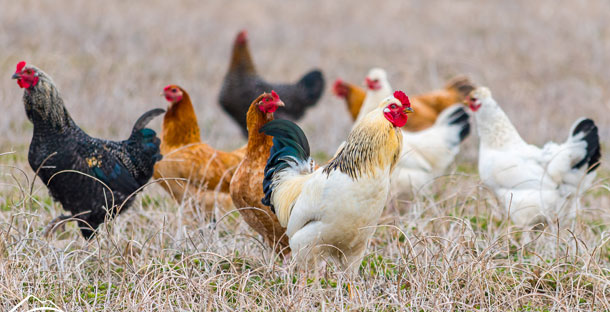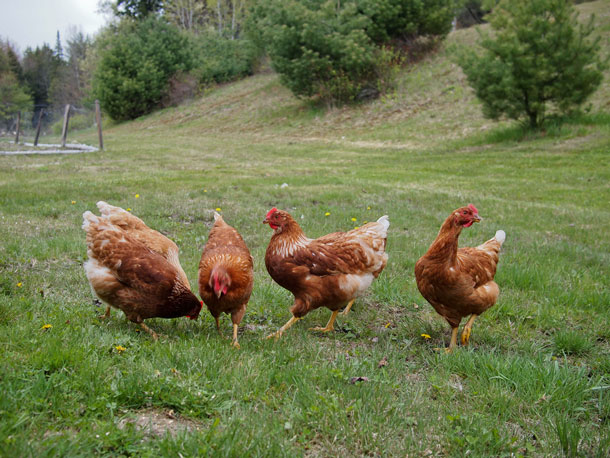BirdNote®: How Free Is A Free-Range Chicken?
Air Date: Week of November 9, 2018

Free-range chickens do not always have full access to open pastures. Even outdoor time totalling a few minutes a day can earn chickens the free-range designation. (Photo: Washington State Department of Agriculture CC)
When it comes to buying meat, certifications can be confusing. The term “free-range” chicken sounds good, but what exactly does it mean? If you’re looking for humanely raised poultry, there are a few labels to be aware of, BirdNote’s® Mary McCann tells us.
Transcript
[BIRD NOTE THEME]
CURWOOD: One of the many creatures that Sy Montgomery has learned from are her backyard chickens, or the ladies, as she calls them. The humble chicken is also the subject of this week’s BirdNote from Mary McCann.
BirdNote®
How Free Is a Free-range Chicken?
Chickens are awake and ready to go well before dawn...
[Rooster crowing]
… and they start foraging at the first glimmer of morning light. They are laying eggs while you are still sipping your morning coffee.
[Chickens clucking]
But what exactly is a “free range” chicken? Next time you’re at the grocery store, take a look at the labels. According to the USDA, which regulates food labeling, “free range” or “free roaming” chickens need only be allowed some kind of access to the outside. That could mean all-day access to a lush pasture, or a tiny enclosure behind a door open for just a few minutes a day.

When chickens are raised “free-range,” their diet can be composed of different bugs and vegetation found in your own backyard. (Photo: Adam Chandler CC)
What if the label says “humanely raised”? It turns out, the standards behind that labeling can also vary quite a lot.
So if you wish to eat truly free-range chickens or eggs, how do you know what to look for?
Chickens raised for meat or eggs — that spend their days outside pecking for bugs, grubs, and fresh green vegetation — are best known as pastured poultry.
Look for labels that show the chicken was pasture raised or “Animal Welfare Approved.” If you can, buy from a local farmer. Or, if you have a big back yard, maybe even try raising your own chickens at home!
(Chickens clucking)
Your decisions at the grocery store can really make a difference – for local farmers and chickens alike.
I’m Mary McCann
###
Written by Bob Sundstrom
Chicken sounds recorded by C Peterson
BirdNote’s theme music was composed and played by Nancy Rumbel and John Kessler.
Producer: John Kessler
Managing Producer: Jason Saul
Associate Producer: Ellen Blackstone
© 2018 Tune In to Nature.org November 2018 Narrator: Mary McCann
References:
Pasture-raised labeling
http://homeguides.sfgate.com/benefits-freerange-chicken-79307.html
What is a “real” free-range chicken?
http://smithmeadows.com/farm/what-is-free-range-chicken/
https://www.birdnote.org/show/how-free-free-range-chicken
CURWOOD: For pictures, flock on over to our website, LOE.org
Links
Learn more on the BirdNote website
What that “Animal-Welfare Approved” certification really means
Living on Earth wants to hear from you!
Living on Earth
62 Calef Highway, Suite 212
Lee, NH 03861
Telephone: 617-287-4121
E-mail: comments@loe.org
Newsletter [Click here]
Donate to Living on Earth!
Living on Earth is an independent media program and relies entirely on contributions from listeners and institutions supporting public service. Please donate now to preserve an independent environmental voice.
NewsletterLiving on Earth offers a weekly delivery of the show's rundown to your mailbox. Sign up for our newsletter today!
 Sailors For The Sea: Be the change you want to sea.
Sailors For The Sea: Be the change you want to sea.
 The Grantham Foundation for the Protection of the Environment: Committed to protecting and improving the health of the global environment.
The Grantham Foundation for the Protection of the Environment: Committed to protecting and improving the health of the global environment.
 Contribute to Living on Earth and receive, as our gift to you, an archival print of one of Mark Seth Lender's extraordinary wildlife photographs. Follow the link to see Mark's current collection of photographs.
Contribute to Living on Earth and receive, as our gift to you, an archival print of one of Mark Seth Lender's extraordinary wildlife photographs. Follow the link to see Mark's current collection of photographs.
 Buy a signed copy of Mark Seth Lender's book Smeagull the Seagull & support Living on Earth
Buy a signed copy of Mark Seth Lender's book Smeagull the Seagull & support Living on Earth

